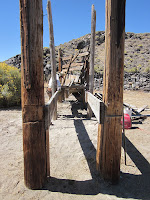Abandoned mines can be hazards to human health and safety as well as essential maternity and hibernation habitat for bat species. Balancing these two issues can be a challenge. With the expertise of Dr. Pat Brown, we're able to plan mine closures that keep people safe and maintain habitat for the bats. Bat gates are installed on addits and shafts with larger numbers of bats. Some mine features don't appear to have any bats using them, and we're able to "hard close" the portals. They're either filled with rocks and dirt or polyurethane foam (PUF). To prevent any bats from being trapped inside, we first exclude them by covering the portals with chicken wire after any fly out. Bats are able to crawl out through the chicken wire if we miss them, but are unwilling to put in the effort to crawl back in and will find another hole that won't be closed. However, we need to finish the hard closures before hibernation season, since that's a good enough reason for the bats to make the effort to re-enter. Timing is everything!
 excluded shaft |  unrolling the exclusion |
 mounting a large exclusion |  night sky through IR goggles |





















































